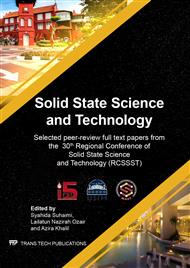[1]
X. Li, W. Bingqing, Supercapacitors Based on Nanostructured Carbon, Nano Energy. 2(2) (2013) 159-173.
Google Scholar
[2]
M.Y. Ayad, M. Becherif, A. Henni, Vehicle Hybridization with Fuel Cell, Supercapacitors and Batteries by Sliding Mode Control. Renewable Energy, 36, (2011) 2627-2634.
DOI: 10.1016/j.renene.2010.06.012
Google Scholar
[3]
G.A. Snook, P. Kao, S. Adam, Best, Conducting-Polymer-Based Supercapacitor Devices and Electrodes. Journal of Power Sources, 196, (2011) 1-12.
DOI: 10.1016/j.jpowsour.2010.06.084
Google Scholar
[4]
M. Domingo-García, J.A. Fernandez, M.C. Almazán-Almazána, F.J. López-Garzóna, F. Stoecklic, T.A. Centenob, Poly(ethylene terephthalate)-based carbons as electrode material in supercapacitors. Journal of Power Sources, 195, (2010) 3810–3813.
DOI: 10.1016/j.jpowsour.2009.12.090
Google Scholar
[5]
H.J. Choi, S.M. Jung, J. M. Seo, D.W. Chang, L. Dai, B. Jong-Beom, Graphene for Energy Conversion and Storage in Fuel Cells and Supercapacitors. Nano Energy, 1, (2012) 534-551.
DOI: 10.1016/j.nanoen.2012.05.001
Google Scholar
[6]
C. Zheng, W. Qian, C. Cui, Q. Zhang, Y. Jin,, M. Zhao, P. Tan, F. Wei, Hierarchical Carbon Nanotube Membrane with High Packing Density and Tunable Porous Structure for High Voltage Supercapacitors. Carbon, 50, (2012) 5167-5175.
DOI: 10.1016/j.carbon.2012.06.058
Google Scholar
[7]
D.P. Dubal, H. Rudolf, Self-Assembly of Stacked Layers of Mn3O4 Nanosheets Using a Scalable Chemical Strategy for Enhanced, Flexible, Electrochemical Energy Storage, Journal of Power Sources, 238 (2013) 274-282.
DOI: 10.1016/j.jpowsour.2013.01.198
Google Scholar
[8]
D.P. Dubal, G.S. Gund, H.R., Lokhande, C.D., Jadhav, P. Chan-Jin, Solution-Based Binder-Free Synthetic Approach of RuO2 Thin Films for All Solid State Supercapacitors, Electrochimica Acta, 103 (2013) 103-109.
DOI: 10.1016/j.electacta.2013.04.055
Google Scholar
[9]
L. S. Aravinda, K. U. Bhat, B. R. Bhat, Nano CeO2/activated Carbon Based Composite Electrodes for High Performance Supercapacitor, Materials Letters, 112, (2013) 158-161.
DOI: 10.1016/j.matlet.2013.09.009
Google Scholar
[10]
L.S. Aravinda, U. Bhat, B.R. Bhat, Binder Free MoO3/Multiwalled Carbon Nanotube Thin Film Electrode for High Energy Density Supercapacitors. Electrochimica Acta, 112, (2013) 663-669.
DOI: 10.1016/j.electacta.2013.08.114
Google Scholar
[11]
M. A. Hashim, L. Sa'adu, Design, Fabrication and Characterization of a Commercially Prepared Carboxyl Multiwalled Carbon Nanotubes with a Hybrid Polymer Electrolytes. Applied Physics Research; Vol. 6, No. 4; (2012) 106-118.
DOI: 10.5539/apr.v6n4p106
Google Scholar
[12]
H. B. Gu, J.-U. Kim, H.-W. Song, G.-C. Park, B.-K. Park, Electrochemical Properties of Carbon Composite Electrode with Polymer Electrolyte for Electric Double-Layer Capacitor. Electrochimica Acta, 45, (2000) 1533-1536.
DOI: 10.1016/s0013-4686(99)00370-9
Google Scholar
[13]
K.V. Kumar, G. Suneeta Sundar, Conductivity Studies of (PEO +KHCO3) Solid Electrolyte System and its Application as an Electrochemical Cell. Journal of Engineering Science and Technology, 5, (2010) 130-139.
Google Scholar
[14]
Y.-J. Zhang, Y.-D. Huang, W. Lei, Study of EVOH Based Single Ion Polymer Electrolyte: Composition and Microstructure Effects on the Proton Conductivity. Solid State Ionics, 177, (2006) 65-71.
DOI: 10.1016/j.ssi.2005.10.008
Google Scholar
[15]
C. C. Yang, Chemical Composition and XRD Analyses for Alkaline Composite PVA Polymer Electrolyte. Materials Letters, 58, (2004) 33-38.
DOI: 10.1016/s0167-577x(03)00409-9
Google Scholar
[16]
K. Ragavendran, P. Kalyani, A. Veluchamy,, S. Banumathi,, R. Thirunakaran,, , T. J. Benedict, Characterization of Plasticized PEO Based Solid Polymer Electrolyte by XRD and AC Impedance Methods. Portugaliae Electrochimica Acta, 22, (2004) 149-159.
DOI: 10.4152/pea.200402149
Google Scholar
[17]
S. K. Tripathi, A. Gupta, K. Manju, Studies on Electrical Conductivity and Dielectric Behaviour of PVdF-HFP-PMMA-NaI Polymer Blend Electrolyte. Bull. Mater. Sci., 35, (2012) 969-975.
DOI: 10.1007/s12034-012-0387-2
Google Scholar
[18]
M. Ulaganathan, R. Nithya, S. Rajendran, Surface Analysis Studies on Polymer Electrolyte Membranes Using Scanning Electron Microscope and Atomic Force Microscope. Intech, 33, (2012) 671-694.
DOI: 10.5772/34948
Google Scholar
[19]
C.-W., Kuo, C.-W. Huang, B.-K. Chen, W.-B. Li, P.-R. Chen, T.-H. Ho, C.-G. Tseng &, W. Tzi-Yi, Enhanced Ionic Conductivity in PAN-PEGME-LiClO4-PC Composite Polymer Electrolytes. Int. J. Electrochem. Sci., 8, (2013) 3834-3850.
Google Scholar
[20]
R. Yang, S. Zhang, L. Zhang, L. Wenbo, Electrical Properties of Composite Polymer Electrolytes Based on PEO-SN-LiCF3SO3. Int. J. Electrochem. Sci., 8, (2013) 10163-10169.
Google Scholar
[21]
L. Sa'adu, M.A. Hashim, B.B. Masbudi, Conductivity Studies and Characterizations of PVA-Orthophosphoric Electrolytes, Journal of Materials Science Research, 3(2014) 48-58.
Google Scholar
[22]
L. Sa'adu, M.A. Hashim, B.B. Masbudi, A Noble Conductivity Studies and Characterizations of PVA-Orthophosphoric-Filter Paper Electrolytes, Journal of Materials Science Research, 3 (2014) 1-12.
DOI: 10.5539/jmsr.v3n4p1
Google Scholar
[23]
Shu, D., Lv, C., Cheng, F., He, C., Yang, K., Nan, J., L Long., "Enhanced Capacitance and Rate Capability of Nanocrystalline VN as Electrode Materials for Supercapacitors, Int. J. Electrochem. Sci. 8 (2013) 1209 – 1225.
Google Scholar
[24]
C. Tran, K. Vibha, Fabrication of Porous Carbon Nanofibers with Adjustable Pore Sizes as Electrodes for Supercapacitors, Journal of Power Sources, 235(2013) 289-296.
DOI: 10.1016/j.jpowsour.2013.01.080
Google Scholar
[25]
H. Pan, J. Li, Y. P Feng, Carbon Nanotubes for Supercapacitor, Nanoscale Research Letters, 5 (2010) 654-668.
Google Scholar


